Sinfonia Verde is an off-grid home that merges with the surrounding jungle ecology in Costa Rica. It floats over the jungle floor, almost disappearing with its permeability—an ideal way, it would seem, for inhabiting the jungle.
 Sinfonia Verde is a residence for a pair of researchers—a climate scientist and a marine biologist—who profoundly influenced the project’s design. Frederik Dolmans, the project architect, says, “The clients, who are deeply involved in climate change research and restoration activities, were very adamant that we create a building that was as low-impact and synchronized with the ecology as possible. With one of their projects being in the nearby Gulfo Dulce, they wanted to live in the jungle but also make sure that their habitation didn’t jeopardize the flora and the fauna around them.” The house is disc-shaped sits on stilts on a heavily sloped site, preventing disruption to the groundwater and allowing animals and root systems to cross below.
Sinfonia Verde is a residence for a pair of researchers—a climate scientist and a marine biologist—who profoundly influenced the project’s design. Frederik Dolmans, the project architect, says, “The clients, who are deeply involved in climate change research and restoration activities, were very adamant that we create a building that was as low-impact and synchronized with the ecology as possible. With one of their projects being in the nearby Gulfo Dulce, they wanted to live in the jungle but also make sure that their habitation didn’t jeopardize the flora and the fauna around them.” The house is disc-shaped sits on stilts on a heavily sloped site, preventing disruption to the groundwater and allowing animals and root systems to cross below.
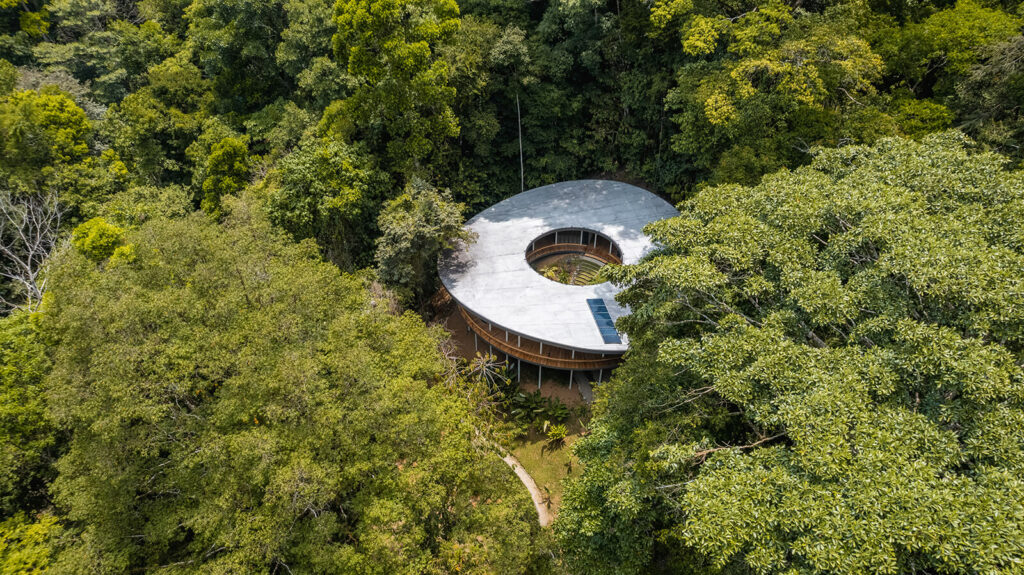 The architect said, “Just to get there was an adventure in itself. We had to trek through the jungle after a two-hour drive from the closest town. As we approached the site, we saw light shining down through the canopy, which is rare in the dense jungle full of tall trees. As we got closer, we realized that the opening had been created by a giant tree that had fallen on the property many years ago, and it had formed a clearing that bathed one in sunlight and gave a view of the passing clouds.” He continued, “Standing in the center of the clearing, your senses were immersed in the sounds of the jungle coming through and resonating around you—the howler monkeys in the distance, the buzzing insects, the leaves rustling, the rain falling through the canopies, a river in the distance. It was a panoramic visual and auditory experience. So the inspiration for Sinfonia Verde came from the desire to perceive the jungle in every direction, where you sense its density and energy, but then also create a space in the center to stimulate a feeling of security where you’re slightly separated from the darkness. That gave rise to the idea of creating a disc, where you had an interface with the jungle on the external edge and a more contained, more secure private sanctuary in the center.”
The architect said, “Just to get there was an adventure in itself. We had to trek through the jungle after a two-hour drive from the closest town. As we approached the site, we saw light shining down through the canopy, which is rare in the dense jungle full of tall trees. As we got closer, we realized that the opening had been created by a giant tree that had fallen on the property many years ago, and it had formed a clearing that bathed one in sunlight and gave a view of the passing clouds.” He continued, “Standing in the center of the clearing, your senses were immersed in the sounds of the jungle coming through and resonating around you—the howler monkeys in the distance, the buzzing insects, the leaves rustling, the rain falling through the canopies, a river in the distance. It was a panoramic visual and auditory experience. So the inspiration for Sinfonia Verde came from the desire to perceive the jungle in every direction, where you sense its density and energy, but then also create a space in the center to stimulate a feeling of security where you’re slightly separated from the darkness. That gave rise to the idea of creating a disc, where you had an interface with the jungle on the external edge and a more contained, more secure private sanctuary in the center.”
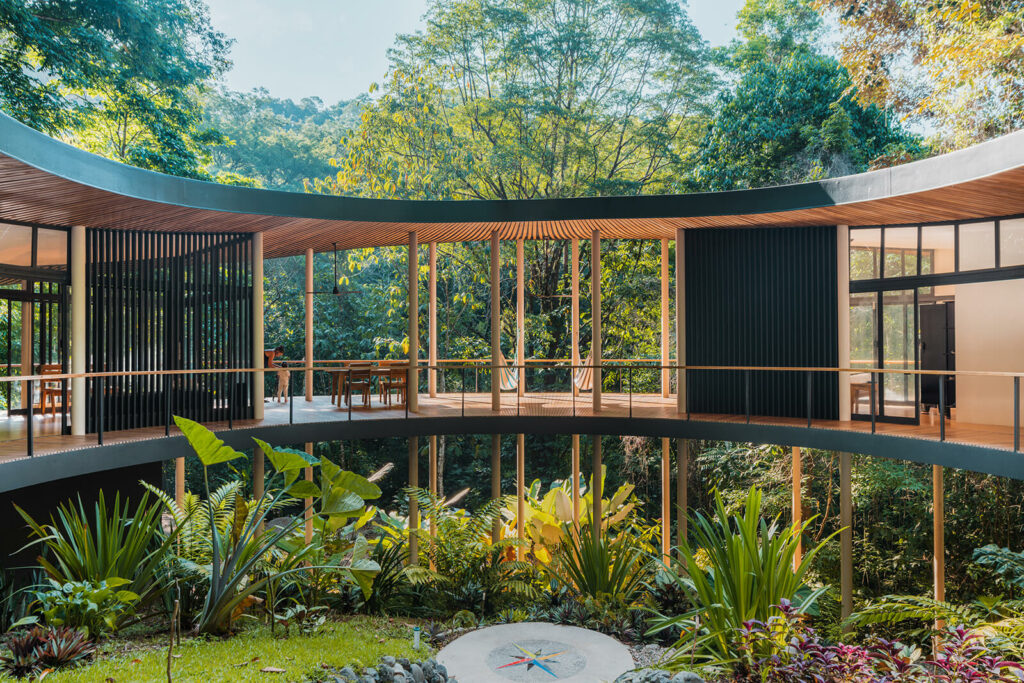 The design comprises two bedrooms, a living room and a kitchen along with a laboratory library, interspersed with shaded outdoor terraces from which to observe wildlife. With jaguars, monkeys and other animals in the vicinity, the landscape architecture of the courtyard acts as a small haven amid an untamed ecosystem. In a region characterized by extreme heat and humidity, the permeable nature of the courtyard house then significantly encourages passive ventilation. The slatted screens allow fresh air to permeate into the home while also providing a sense of security. The hyperbolic form of the roof is designed to shelter the house from the region’s intense rain and sun while also directing the water into natural streams to not alter the micro-ecology of the area.
The design comprises two bedrooms, a living room and a kitchen along with a laboratory library, interspersed with shaded outdoor terraces from which to observe wildlife. With jaguars, monkeys and other animals in the vicinity, the landscape architecture of the courtyard acts as a small haven amid an untamed ecosystem. In a region characterized by extreme heat and humidity, the permeable nature of the courtyard house then significantly encourages passive ventilation. The slatted screens allow fresh air to permeate into the home while also providing a sense of security. The hyperbolic form of the roof is designed to shelter the house from the region’s intense rain and sun while also directing the water into natural streams to not alter the micro-ecology of the area.
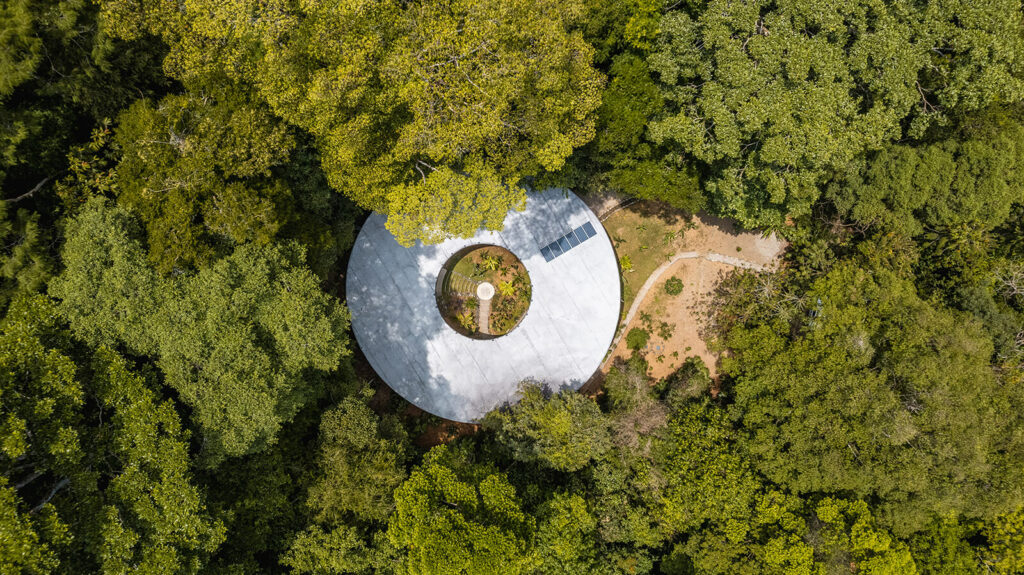 This project is completely off-grid, generating power through solar panels and a hydro turbine in a nearby stream, which also supplies drinking water. The energy-efficient lighting and responsibly sourced materials such as teak and cork further reduce the environmental impact.
This project is completely off-grid, generating power through solar panels and a hydro turbine in a nearby stream, which also supplies drinking water. The energy-efficient lighting and responsibly sourced materials such as teak and cork further reduce the environmental impact.
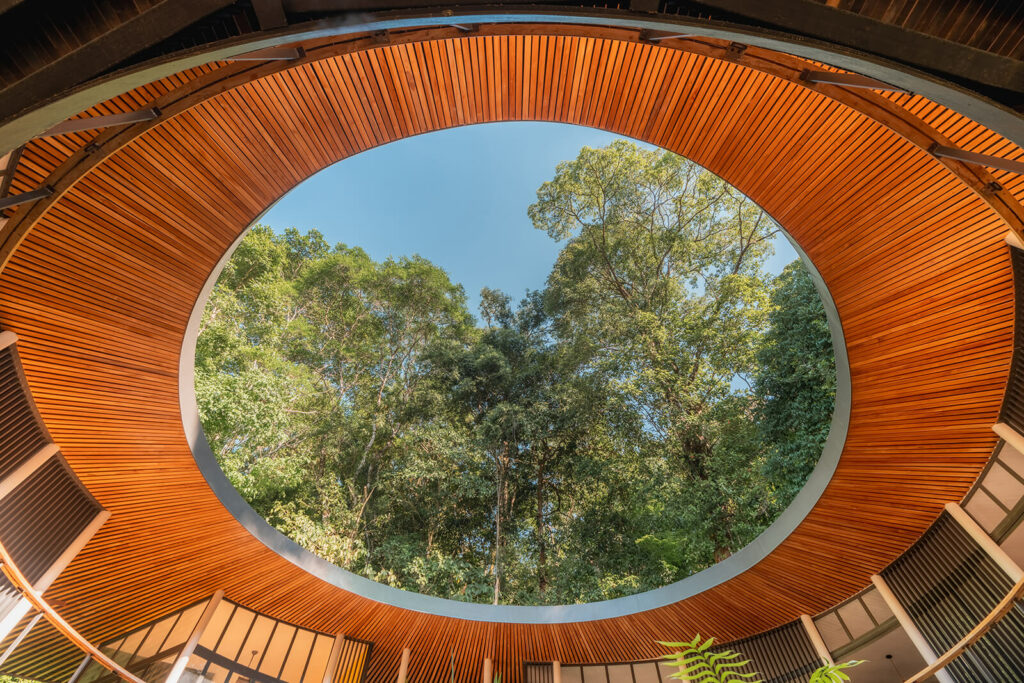 A walk along the 360 degrees of the platform constantly shifts your attention: from skyline to secondary forest, to earthy terrain, to primary forest and back again to skyline.
A walk along the 360 degrees of the platform constantly shifts your attention: from skyline to secondary forest, to earthy terrain, to primary forest and back again to skyline.
For the prefabricated structure, steel components were prepared in advance, delivered during the dry season and assembled by hand. The dynamic roof form was created with a woven grid of uniquely pitched beams and was then covered with fiber cement boards and a durable membrane to withstand the harsh environment.
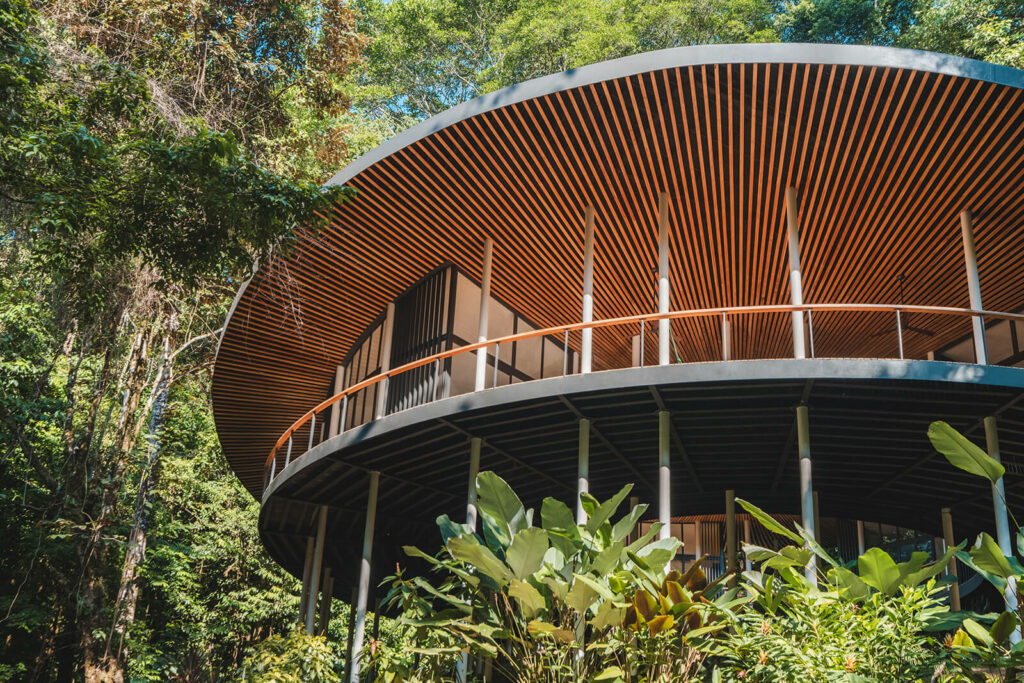 Sinfonia Verde, Spanish for ‘Green Symphony’, has a simple yet effective design that is a product of innumerable smaller considerations that need to be evaluated when dealing with buildings in sensitive zones. An inherently sustainable approach, if made mainstream, could revolutionize how we continue to build into the future.
Sinfonia Verde, Spanish for ‘Green Symphony’, has a simple yet effective design that is a product of innumerable smaller considerations that need to be evaluated when dealing with buildings in sensitive zones. An inherently sustainable approach, if made mainstream, could revolutionize how we continue to build into the future.
You can read the original article at www.stirworld.com

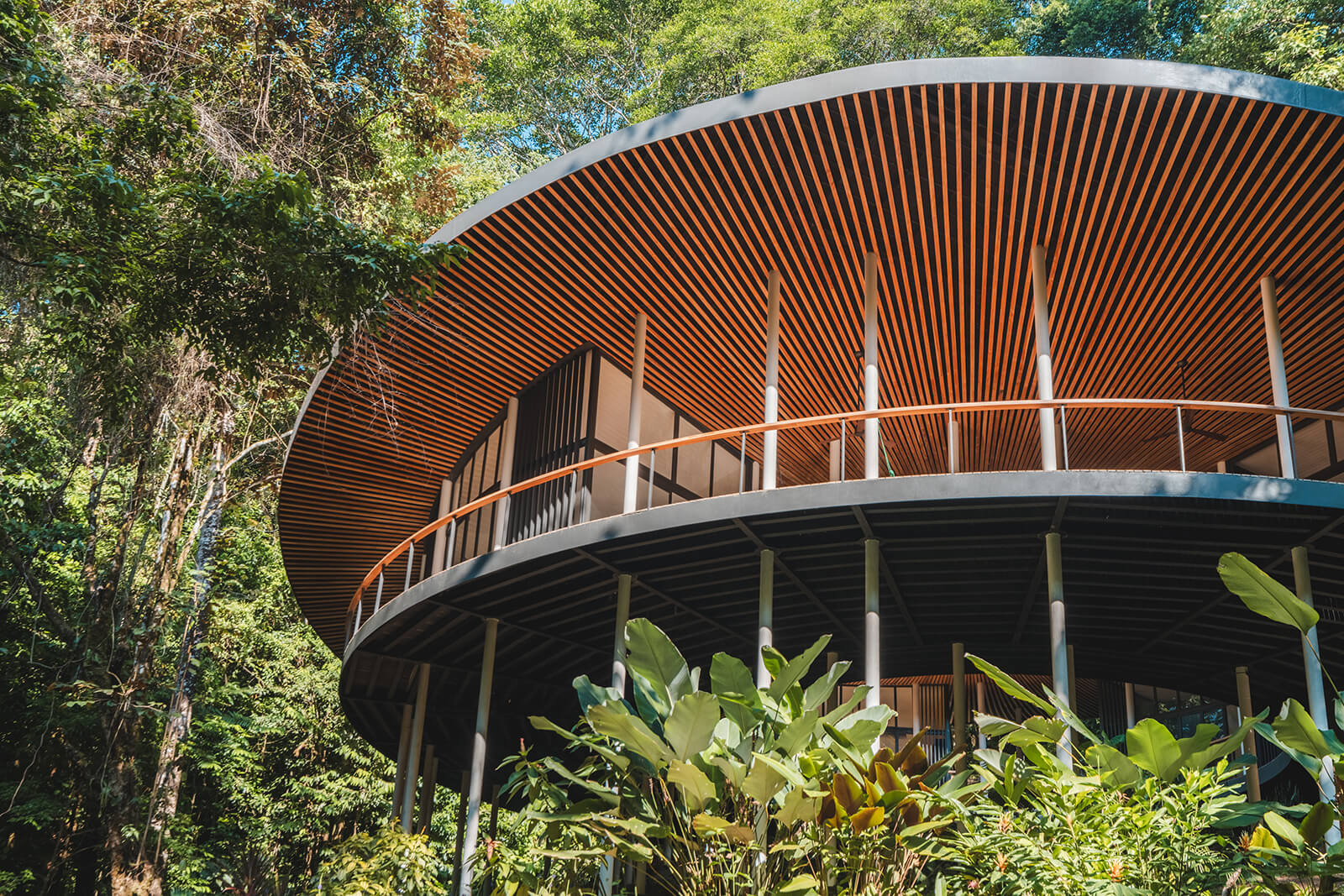
It would behove the non-scientific population to take heed and maybe follow suit.